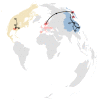Global patterns of avian influenza A (H7): virus evolution and zoonotic threats
- PMID: 31381759
- PMCID: PMC8038931
- DOI: 10.1093/femsre/fuz019
Global patterns of avian influenza A (H7): virus evolution and zoonotic threats
Abstract
Avian influenza viruses (AIVs) continue to impose a negative impact on animal and human health worldwide. In particular, the emergence of highly pathogenic AIV H5 and, more recently, the emergence of low pathogenic AIV H7N9 have led to enormous socioeconomical losses in the poultry industry and resulted in fatal human infections. While H5N1 remains infamous, the number of zoonotic infections with H7N9 has far surpassed those attributed to H5. Despite the clear public health concerns posed by AIV H7, it is unclear why specifically this virus subtype became endemic in poultry and emerged in humans. In this review, we bring together data on global patterns of H7 circulation, evolution and emergence in humans. Specifically, we discuss data from the wild bird reservoir, expansion and epidemiology in poultry, significant increase in their zoonotic potential since 2013 and genesis of highly pathogenic H7. In addition, we analysed available sequence data from an evolutionary perspective, demonstrating patterns of introductions into distinct geographic regions and reassortment dynamics. The integration of all aspects is crucial in the optimisation of surveillance efforts in wild birds, poultry and humans, and we emphasise the need for a One Health approach in controlling emerging viruses such as AIV H7.
Keywords: H7; One Health; avian influenza; influenza A virus; virus evolution; zoonosis.
© FEMS 2019.
Figures




References
-
- Alexander DJ. A review of avian influenza in different bird species. Vet Microbiol. 2000;74:3–13. - PubMed

